|
Are
your subplots as effective as your main plot? Often a novel can be
enhanced by an effective secondary plot or two. Here are a few
pointers:
1. Allow the subplot
to grow naturally out of your characters’ (particularly the
protagonist’s) personal lives. This might be a romantic
subplot. Or a plot involving a problem that the character continually
faces. For example, in my Hidden Faces suspense series, Annie’s son,
Stephen, provides a dramatic subplot in the first three books. He’s
been a rebellious kid and is falling more and more into drug use. As
Annie faces her struggles with a murder case, working as a forensic
artist, she’s continually pulled away to deal with Stephen’s problems.
This leads to a higher level of tension in Annie’s life—and therefore
in the novel.
In many novels, particularly
suspense, tension arises from that corkscrew effect of things in the
protagonist’s life turning tighter and tighter. A messed-up kid, or
some other relationship, a physical handicap or illness, a loss—any of
these things can help make things difficult for the protagonist. With a
good subplot going, you can let the main suspense plot hang (after
creating a strong hook, of course) and focus on the growing
difficulties coming from these other issues in the character’s life.
2. A good subplot
dovetails into the main plot. I’ve read books with personal
issue subplots that never affect the main plot at all. It’s just this
side thing going on in the character’s life. I come away from those
books feeling as if the author couldn’t think of a main plot deep
enough to fill the pages, so this subplot had to be tacked on. Just
doesn’t work for me. The plots may start out separately, but they
should begin to affect each other. And toward the end of the novel, the
crisis/climax of your subplot should help drive and deepen the
crisis/climax of your main plot.
3. A subtle approach
to bringing the two plots together could be called the “Finite Energy”
technique. As problems in a protagonist’s personal life weigh
her down and sap her energy, she’s left with less vitality to fight in
the main plot. The added vulnerability and exhaustion can lead her to
overlook an obvious clue, tempt her to give up, and in general push her
closer to the brink. And of course, in my genre of suspense, it’s all
about torturing your protagonist. She’s got to end up at the brink, or
the reader’s not likely to feel satisfied. (Suspense readers are a
sadistic lot.)
4. A
second way of bringing subplot and main plot together could be called
“Converging Streams.” This is the approach I used in the
Hidden Faces books. Some examples (general enough not to give away the
story): In Brink of Death, (book 1), Annie makes a
choice of where to go because of her son’s issues. That choice places
her in a location in which she ends up doing something in regard to the
main suspense plot. In Stain of Guilt (book 2),
|
Stephen’s
choices directly affect what happens to his mother in the
main plot. In Dead of Night (book 3), there is a
real clashing of the main serial killer plot and the son’s subplot. The
foundation for that ultimate clash is set up right in the beginning of
the book. The very short prologue deals with the serial killer main
plot. Chapter 1 deals with the son’s subplot. Chapter 2 goes back to
the main plot. I would not have appointed such an important
chapter—chapter 1—to deal with a subplot without a strong reason. And
even as chapter 1 deals with the subplot, Annie’s reactions and choices
are largely fueled by what’s going on in the main plot.
You can also create subplots
based on secondary characters. These, too, should end up affecting the
protagonist and the main plot in some way. Otherwise they’re going to
feel tacked on.
A character is the sum of his
experiences, just as a real person is. So even as your character faces
a major dangerous crisis in his life, all these surrounding, smaller
things are still happening. He may be fighting with a roommate, he may
be about to lose his job. The possibilities are endless. Bottom line, a
good subplot helps to characterize your protagonist and create him into
a more three-dimensional person.

 |